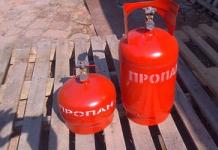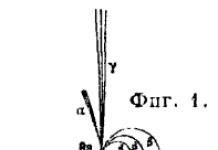The idea of using waste oil as an energy carrier to heat buildings is not new. In view of large quantity processing at car service stations, especially trucks, a problem arose with its disposal. It is not surprising that various units, both factory-made and home-made, have appeared that make it possible to effectively burn this substance and obtain from it thermal energy. One of similar devices- Babington burner on waste oil, we will consider it in this material, and we’ll also tell you how you can do it yourself.
What is a Babington burner?
The diesel burner design was patented by Robert Babington in 1979. However, the patent expired, after which all information about the device and operating principle of the unit became publicly available, as did the drawings of the Babington burner. As a result, many craftsmen were able to repeat this design, only instead of diesel fuel they used used automobile oil, and later other types of liquid oils.
It is not easy to effectively burn old oils, since waste from the same car service is a mixture of oils of different viscosities with big amount impurities. It also contains gasoline, diesel fuel and even antifreeze in small proportions. All these points are taken into account by the design of factory-made burners; filter elements are built into them.
Another thing is the Babington burner; no filtering is required for its operation, and here’s why. The fuel in it flows down the spherical surface, forming a thin film, and in the center of this sphere a small hole(0.1-0.3 mm in diameter) for supplying air under pressure. The basic principle of operation of the burner during extraction is that the air escaping from the hole breaks off part of the oil flowing down the surface. The result is a torch of air-fuel mixture capable of ignition.
The amount of dirt in the exhaust only affects the combustion efficiency; the burner operates on exhaust and is not clogged with impurities suspended in it, since there are no narrow passages or holes with small diameters in the fuel path, as in nozzles. There is only one hole here, only air passes through it. Instead of complex system filtration, the waste oil burner device provides for the supply of fuel to a spherical surface, and its excess, which does not fall into the torch, flows down into the sump.

An indispensable condition for high-quality combustion is preheating of old oils. This is necessary for 2 reasons:
- Increased turnover. Thanks to this, the substance covers the surface of the sphere well and, when air is supplied, is better atomized, forming a stable aerosol plume.
- Reduced flash point. Using heated oil, it is easier to ignite the Babington burner, and during operation it makes maximum use of the fuel energy, releasing more heat.
How this burner functions is clearly shown in the video:
What is the difference between a blowtorch and a Babington burner?
The operation of a supercharged burner is often compared to the combustion of the well-known blowtorch. Indeed, their structure has certain similarities. But the principle of operation is completely different. In a blowtorch, gasoline in a closed container is exposed to overpressure air created hand pump. This air does not mix with the fuel, but only pushes it upward, towards the nozzle. Along the way, the gasoline warms up and evaporates in the pipe casing, after which it enters the injector nozzle. Coming out of it, the fuel mixes with air and burns, forming a powerful torch of flame.
Everything happens the other way around in a vertical Babington burner during processing. Air, not fuel, is blown through the nozzle, while the contaminated oil does not evaporate, but is only heated to certain temperature(no more than 70 ºС). In this case, the liquid does not burn completely; part of it goes into the sump. Due to the fact that it is extremely difficult to evaporate the waste and feed it through the nozzle into the combustion zone, it is not possible to make a burner using the waste from a blowtorch. Just like filling a Babington unit with gasoline, this is not only ineffective, but also downright dangerous.
Advantages and disadvantages
The main advantage due to which it gained wide popularity homemade burner at Babington's development, this is her omnivorousness, as already mentioned above. In fact, you can pour any heated oil of a reasonable degree of contamination onto a spherical surface, and a properly made burner will still work stably. It is not afraid of gasoline or antifreeze impurities, unless their ratio with oil is one to one, then problems will inevitably arise. And then, this is not at all a reason to get rid of such a mixture; for the burner to function normally using waste oil, it will need to be well diluted with the “correct” treatment, and then put into use.
Another advantage is the simplicity of the design, which is why craftsmen quickly mastered this product. Indeed, making the “heart” of the device from a ball or hemisphere placed in a body is quite simple. It is somewhat more difficult to organize the fuel supply and air injection, and even to configure the entire system so that the DIY Babington burner operates stably and safely. But there is wide scope for the implementation of various technical solutions.
Of the serious shortcomings of the unit, only one is striking. This is the constant presence of dirt in the room where the liquid fuel burner operates. Unfortunately, it is impossible to completely eliminate accidental spills or seepage of contaminated machine oil through leaks, even if all connections are sealed and an automatic Babington burner is installed. To one degree or another, the room will be dirty, you will have to come to terms with it.

Due to its popularity and simplicity, the burner for the boiler during mining is manufactured by craftsmen in different variations, we will undertake to describe the most simple design, which will be available for replay at home. First you need to select the necessary materials, here is their list:
- Steel tee with internal threads with a diameter of 50 mm - for the body.
- Sgon with external thread with a diameter of 50 mm - for the nozzle. Its length is optional, but not less than 100 mm for the nozzle.
- Metal elbow DN10 with external threads - for connecting the fuel line.
- Copper tube DU10 of the required length, but not less than 1 m - to the fuel line.
- A metal ball or hemisphere that fits freely into the tee is for the working part.
- A steel tube of at least DN10 is used to connect the air duct.
To make a burner for testing with your own hands, you need to perform one precise operation - make a hole in the center of the sphere. Hole diameter – from 0.1 to 0.4 mm, perfect option– 0.25 mm. It can be done in 2 ways: drill with a tool of the appropriate diameter or install a ready-made jet at 0.25 mm.
Important! The hole must be made strictly in the center, and its axis must be parallel to the walls of the housing (tee) in which the sphere will be installed. The deviation is allowed to be minimal, otherwise the torch will hit to the side, which will affect stable work and burner consumption.

It is not easy to accurately make such a small hole; thin drills easily break. Instructions on how to do this correctly are shown below:
Another way to make a calibrated hole in the spherical part of an autonomous burner is to insert a nozzle of the required diameter there. To do this, a hole is drilled, the diameter of which is slightly less than the outer diameter of the nozzle, and processed with a reamer. The jet is pressed inside and polished, as described in the video:
Note. If you need to make high-power burners, then the diameter of the nozzle can be increased to 0.4-0.5 mm or 2 small holes can be drilled, keeping a distance of at least 7 mm between them.
When this operation is completed, we assemble the burner based on the drawing:

A hole must be made on the side of the nozzle wide enough to ignite the unit. A large fuel heating spiral is not needed, 2-3 turns are enough. Ready product can be mounted on a mounting plate and built into any boiler, including a homemade one. At the end of the work, you need to connect the air and fuel lines, and then organize the supply of oil and air. The simplest way fuel supply - by gravity, for this purpose the container with the waste is suspended from the wall above the burner device and a tube is laid from it.
If you use a pump to pump oil, then you can subsequently use control sensors and a control unit, then you will succeed automatic burner, which will be safer to operate. detailed instructions on the selection of materials and assembly of the device is shown in the video:
If everything is done correctly and the diameter of the air hole is 0.25 mm, then the fuel consumption of the burner should not exceed 1 liter per hour. There should be no black soot during combustion; you need to achieve even burning of the torch. The adjustment is carried out by moving the sphere back and forth or changing the air pressure. Any compressor can cope with its injection, even from a refrigerator, since operating pressure never exceeds 4 Bar.
Conclusion
Making a Babington burner with your own hands is good decision for those who have the opportunity to inexpensively purchase old motor oils. With some skills, it is not difficult to integrate the device into a combustion chamber with a water jacket and a chimney, then you will get a homemade supercharged waste oil boiler for heating your home.
Burner for furnace in production
During the onset of cold weather, every resident of our country begins to think about how to warm their home. For this purpose, many have now been developed various systems. They all differ in the type of fuel they use, as well as the price of the devices themselves. The simplest and cheapest device for heating a summer house or utility room that you can make with your own hands is a working burner.
Burners can be divided into several types:
- Lighting.
- Welding.
- Heating.
Based on the fuel used, they can be:
- Gas.
- Liquid fuel.
- Combined.
The history of the appearance of waste engine oil burners
This type of burner has been known for a long time and is widely used, since the waste oil used in them is not just cheap, but practically free compared to gas, electricity or solid fuel.
In the distant 60s of the last century, residents of our country began to acquire summer cottages and build houses on them, which in cold weather had to be heated with something. Although gasoline and other types of fuel were inexpensive, salaries citizens also had small amounts, so people were looking for an alternative to gasoline, wood and coal. And our folk craftsmen have developed with their own hands a system that works in practice.
Its principle of operation was already known. It is similar to kerosene gas, which was used by a lot of people at that time. Kerosene evaporated in it, and then it was burned in a specially designed chamber. This device was relatively safe to use, but had the disadvantage that if it malfunctioned, soot was released and a pungent odor appeared. And this all happened shortly before possible accident. A waste oil burner works on the same principle, only the craftsmen had to think about how to ensure that the combustion of contaminated fuel continues to the very end.
The operation of the device consisted of several stages:
- The initial not too large energy reserve of liquid fuel was allowed to decompose into simpler and lighter fractions. They were the most active. The splitting process is called pyrolysis. This is the thermal decomposition of many inorganic and organic compounds. In a narrow sense, it is the decomposition of organic natural compounds due to a lack of oxygen. In a broad sense - decomposition various connections into several less heavy molecules or elements when exposed to elevated temperature.
- The resulting fractions were burned in several stages.
Advantages and disadvantages of a liquid fuel burner
This equipment has a lot of advantages, the main ones are:
- Easy to make with your own hands and use.
- Wide distribution of drawings for the manufacture of fixtures.
- Cheapness of used oil used as fuel. These devices are perfect for transport organizations and companies where there is a lot of waste. In this way, waste can be disposed of and space heating can be carried out.
- Efficiency and functionality of devices.
- Mobility of the device.
Despite the listed advantages, the burner also has a drawback. It is quite demanding on the quality of used oil.
Features of making your own liquid fuel burner
Externally, the burner resembles an empty gas cylinder small size, to which oppositely directed sections of steel pipe are attached at the top and bottom by welding.
Babington burner
Her inner size is one inch, and the wall is quite thick. The lower section is necessary to supply an oil-air suspension to the compartment where combustion occurs. The upper section is used as a burner bell. A torch of flame with a high temperature emerges from it. To ensure the flow of air that is pumped into the furnace to form a torch, a simple household vacuum cleaner with great power.
Making a burner with your own hands is quite simple. To do this, you will need a welding machine, which is used to connect the parts, as well as a grinder and a lathe.
Manufacturing begins with the body. To do this you need to find an empty gas cylinder suitable size. Then remove the filler hole and use a template to mark the pipe fasteners. Then use an electric drill to drill them along the inside of the circuit. To do this, you need to use a drill in the form of a spiral. With a high degree of accuracy, using a chisel or grinder, you need to remove the jumpers between the holes. In order for the holes for fitting the pipes to be correct form, you need to grind them using a round file by hand. This can also be done with a cutter by placing it in an electric drill. When working with metal, you must follow safety regulations.
In the holes the right size pipes are inserted and welded. The pipes are measured in advance and sawed off with a grinder. A hole is made in the lower half of the pipe and an M16 nut is welded. This hole is necessary for attaching the oil nozzle.
The principle of feeding waste into the burner itself
The oil nozzle is made using lathe. For the base, use a rod that has a smooth shank. It will be required when attaching the oil supply hose. If provided flexible liner, then it is necessary to cut a thread on this part. For most of the length of the rod they make metric thread. The diameter of the pipe is 16 mm. A hole is drilled almost the entire length of the nozzle. It meets with a transverse piece installed at the bottom, the diameter of which is 3 mm. If you have turning skills, then this part is easy to make with your own hands. And if not, then you can order it from a professional.
The principle of operation of the nozzle is based on the flow of viscous waste from a hole drilled in the transverse part and its capture by the air flow. This process breaks the fuel into small droplets. Their combustion is much easier.
Air flow control

Making a furnace during mining
The strength of the fire torch depends on the intensity of the air flow. The adjustment system is based on a steel cup. It has a semicircular bottom and a hole of a certain diameter. This one is enough simple detail can also be done on a lathe. To accurately make the bottom in the form of a hemisphere, you need to use cutters, and, of course, it must be made by a highly qualified turner.
Adjustment of air flow is carried out by a curtain round shape. It is secured to the L-shaped axis using an M4 screw.
To firmly connect the outlet pipe onto which the hose is placed, and to operate the air valve, use an adapter that has a slot along its length.
During arson, access to the exhaust chamber is provided by a lid with a sufficiently large weight. It is installed on pre-welded canopies on the neck of the body. If the part is not such a massive part, then spontaneous opening of the device during operation is possible. If all the steps in assembling the burner were completed correctly, then its operation is accompanied by an even flame. purple, which occurs when the oil-air mixture burns in the body of the device.
When working with a liquid fuel burner, you must follow the rules fire safety. The attachment point of the nozzle itself and the hose through which liquid fuel is supplied must be protected with a steel screen. It will protect used oil from fire if the seal is broken.
Conclusion
Making a burner with your own hands is quite simple. But at the same time, it is necessary to follow safety rules when working with a lathe and performing metalworking operations. And in addition, comply with fire safety requirements, since all work performed involves the use of power tools. You need to be especially careful when choosing a cylinder for the burner body. It must be empty, otherwise, when making holes in it, an unforeseen situation may arise, which is fraught with quite life-threatening injuries to the master.
For heating production premises of any type, a waste oil boiler is often used. If the enterprise constantly accumulates waste from processed oil, then the unit becomes a universal waste reclaimer. The device is also suitable for heating a private home. The only thing you need to pay attention to when installing a boiler for testing is the power of the unit - the lower value due to the specifics of the fuel is 35 kW. Be sure to consider the possibility of purchasing recycled oil.
You can make a heating apparatus in which oil waste is burned yourself. It consists of units that are made from scrap materials.
Waste oil boiler: DanVex B30.Advantages of the boiler and nuances of use
Boilers are installed where autonomy is required heating equipment. It is wrong to think that used oil in liquid form is used to operate the boiler. Heating of the coolant is achieved by burning a mixture of exhaust vapor and air. The advantages of the equipment include:
- Efficiency - 95%
- Autonomy
- Use of any type of oil fuel
- Environmentally friendly - vapors are burned almost completely
- Simple equipment design
- Opportunity
An installed liquid fuel boiler that runs on waste oil pays for itself in a year. The scale of heating costs is approximately as follows: for a house with an area of 350 square meters you will need a 35 kW boiler, which in 5 months heating season will generate 6500 liters of oil waste.
When using equipment during testing, the following nuances should be taken into account:
- Fuel requires a special container - a tank, a tank, a barrel, and it is advisable to store the fuel for the entire heating season or for 2 months
- During cold weather, oil viscosity increases and pumping becomes difficult.
- Noise during operation of the unit
- Chimney cleaning every couple of weeks
Having assessed the advantages and disadvantages, and also taking into account the fact that they can be made independently using waste oil, a decision is made on the advisability of installing the equipment.
Waste oil boiler diagramHow the boiler works and works
The unit has two chambers - evaporation and combustion. The primary supply of fuel takes place into the evaporation chamber using an oil pump, where it is heated to a temperature of 40°C. If the heating is lower, the fuel does not burn completely and excess soot is formed. When the oil overheats, the volume of evaporation increases. In the evaporation compartment, the oil is additionally ignited.
The vapors are fed into the combustion chamber and mixed with air, forming a complete combustible mixture. The water is transferred to the heat exchanger and through it to the coolant. Exhaust boilers with a water circuit have water jacket, which is built into heating unit. After heat transfer, oil combustion products are discharged through the chimney.
The main elements of a boiler operating on used oil:
- The unit body looks like a cylindrical metal tank
- Pump for pumping oil from a storage container into the apparatus
- Compressor for supplying air to oil vapors
- - ensures circular movement of the coolant
- Ignition device - waste oil burners are the most complex element of heating equipment. Fuel is supplied to them for ignition. A sign that the boiler is operating successfully is that the burner burns evenly during exhaust and does not go out.
- Pipes, taps, fittings for supplying coolant to the heating system
- Chimney - a steel pipe is used, since emissions have high temperature and contain condensation. The pipe is retracted into a channel made of concrete or brick
Knowing the structure and principle of operation of the waste heat boiler, as well as having drawings of the unit, it becomes accessible self-assembly heating equipment.
Waste oil boilerManufacturing of boiler and burner
The necessary elements are assembled according to specified dimensions. An empty propane cylinder is adapted for the housing, which is divided into two chambers. Materials for manufacturing are selected in such a way that they can withstand a temperature in the combustion compartment of 700°C.
The main difficulty lies in the do-it-yourself burner, which is assembled independently, since the power of purchased equipment starts from 30 kW. This is exactly how waste burners are produced. Imported ones have much higher power. If, then a power of 10 kW is sufficient.
Stages of device assembly
Waste oil boilers are assembled according to the following algorithm:
- The bottom of the body is separated from the top by a sealed partition. Top mounted pressure pipe, the return line is laid below. The water returning from the batteries should not be mixed with heated water.
- The inner pipe fits into the baffle. It is welded with a continuous seam. The pipe is used as a chimney and combustion chamber at the same time. The holes that are made at the bottom of the pipe help create a flammable air-oil mixture
- The burner is placed in an insulated cylinder. The bottom cover is welded to the combustion chamber, and then a homemade waste oil burner is installed
- Oil and air fittings are mounted in the lower compartment of the housing. For continuous air supply it is installed. It will ensure complete combustion of fuel
- In the inner part of the compartment, pipes are installed that lead to the burner - parts of the combustible mixture will be mixed here
- A homemade door is installed - a DIY waste oil burner needs periodic cleaning.
- Ignition is carried out through a spark plug, the contacts from which are led out through the door
- A valve is installed at the outlet of the pipe from the boiler to regulate draft
Burner options
To prepare the mixture and ignite it, assemble a burner with your own hands.
Different shapes of burners provide the same operating principle, with the mixing zone of the components of the combustible mixture located above the combustion area.
You can make a burner yourself using the Babington scheme. The principle of operation is that the oil flows down the polished hemisphere and covers smooth surface thin layer. A hole with a diameter of 0.25 mm is drilled in the center of the hemisphere. Air is supplied to it under pressure, which, escaping from the hole, turns the oil into a fine mixture. A well-heated mixture serves as fuel if you make a diesel burner yourself using the Babington method. Excess oil flows into special container For reuse. No oil filtration required.
To assemble the burner you will need:
- A head with a hole or a screwed-in jet with a polished surface and a tube on which it is placed. The opposite side of the tube is connected to the air source
- Cast iron tee - diameter 50 mm. The part connects all the structural elements when making a Babington burner with your own hands
- Welded nipple - diameter 50 mm - used for the nozzle, a hole is made in it for ignition with a diameter of 10 mm
- Angle fitting - screwed into the tee from above, used to supply oil to the head, a copper tube is attached to it
- Copper tube for winding the nozzle - oil passes through it and warms up, a couple of turns are enough
When assembling the burner, be sure to use it - all connections are coated with it.
A tube with a hemisphere is attached to one hole of the tee, and a nozzle is installed on the opposite hole. The third hole is connected by a squeegee to a barrel into which unburned oil flows.
If a burner is made using a blowtorch, then difficulties arise with the evaporation of oil and a large number of impurities that clog the nozzle.
WATCH THE VIDEO
Security requirements
Heating units are equipment whose handling requires strict adherence to safety precautions. When they are made by hand, the reliability of each unit is carefully checked. Increased attention is paid to the installation of the chimney and the location of the fuel next to the boiler. The combustion waste removal pipes are made of steel, the passage of the chimney through the roof is isolated, and the waste barrel is placed no closer than 20 meters to the boiler.
The idea of using used machine oil as burner fuel is not new. There are many different schemes for making such a device on the Internet. And the popularity of such products is only growing. This is understandable, because such a device will be very useful in everyday life, heating country house or utility room.
In addition, it has a number of advantages:
- Most of the proposed schemes are simple, and any person with a minimum of necessary skills and tools can assemble it.
- The fuel for this burner is very affordable. It can mainly be found in auto repair shops, where there is simply an overabundance of it. Thus, used oil can be obtained for free or for a minimal amount.
- The question of waste oil disposal often arises. Oh, and such a burner will help to recycle it without harming the environment.
- This device is multifunctional and can be used as a conventional burner or an oil heating system.
- Such a device is usually mobile, as it is light in weight and size.
- This burner is universal in the type of fuel used. In fact, it can operate on any combustible fuel, be it used engine oil, gasoline, kerosene or any other.
Among the many schemes, one is the most interesting in terms of simplicity, functionality and unpretentiousness. This miracle unit is called a Babington burner. She is named after her creator and her design for a long time was unavailable due to a patent. But the patent has expired and now anyone can bring the scheme to life.

The principle of its operation is very simple and includes the following stages and parts:
- Preheated fuel falls on the sphere, spreading over it evenly, forming a thin film.
- A compressor is connected to the sphere itself, pumping air. A very small hole is made in the sphere, with a diameter of 0.1-0.3 mm. Air under pressure exits the sphere through this hole. Passing through the fuel, the air disperses it, forming something like an aerosol.
- Next, this jet is ignited and it turns out to be a burning torch.
- The rest of the unused mining drains into a settling tank and can be reused.
- For that In order for unused waste oil to be automatically supplied to the sphere again, it is necessary to connect a pump to the system, which will supply fuel from the sump.
Preheating the fuel solves 2 problems at once:
- Increased fluidity. The heated waste oil spreads better over the surface of the sphere and is atomized much more easily by the supplied air.
- Facilitates the process of igniting the torch. At the same time, it is not only easier to launch the device, so to speak, but the efficiency also increases.
The advantages of this scheme include:
- Versatility in fuel use. Such a burner is practically independent of the degree of contamination of the liquid energy carrier.
- No filtering required. Due to the fact that there are no narrow passages in the system, except for the air hole, it does not require filtration, unlike factory analogues.
A serious disadvantage of such a burner is that even if it is made almost hermetically and the entire process is controlled automatically, the room will still be polluted.
Do it yourself

The manufacturing process of a Babington burner is not very complicated and if you have all the necessary materials and tools will only take a few days, depending on the person's skills.
To manufacture this unit you will need the following materials:
- steel tube DN10,
- metal tee with a diameter of 50 millimeters with internal thread;
- a metal sphere (or hemisphere) with a diameter of less than 50 millimeters;
- copper tube DN10 at least one meter long;
- metal elbow DN10 with external thread;
- a bend with a diameter of 50 millimeters with an external thread, a length of at least 10 centimeters;
You will also need a minimum set of tools:
- corner Grinder(grinder) or hacksaw;
- perforator;
- special chuck for thin drills;
- drill;
- drill with a diameter of 0.1–0.3 millimeters;
Preparatory stage
Before starting assembly, you need to make a hole in the sphere (hemisphere). This is one of the most difficult and critical stages, since the hole must be made exactly in the middle. Otherwise, the burner torch will be directed to the side, which in turn can negatively affect the quality of the product and its efficiency.
In addition, drilling holes of this diameter is challenging task, as thin drills may break. Therefore, this process must be carried out carefully and slowly.
Step-by-step instruction

Babington burner
Once the sphere or hemisphere is ready, you can begin assembly. It is very simple and consists of several simple manipulations:
- The metal squeegee will act as a nozzle. It is cut to the required length and screwed into the tee. After this, a hole is drilled in the side of the burner, large enough so that the jet can be ignited through it.
- Top of the tee Closer to the nozzle, a hole is made for a copper tube through which fuel will be supplied to the device.
- TO copper tube an elbow is attached to connect the fuel line.
- Copper tube several turns are made (2-3 will be enough) around the nozzle. They must be done at some distance from the drive. This will allow the oil to warm up to desired temperature before it hits the sphere.
- In the sphere at the opposite end from the small hole another one is drilled along the outer diameter of the steel tube. The tube is hermetically inserted into the sphere. This is necessary so that the air exits only through a small hole, and pressure is created inside it. If a hemisphere is used instead of a sphere, then the tube is soldered at the small hole and sealed.
- From the opposite end from the nozzle a metal tube with a sphere is inserted into the tee. She is fixed in it.
- Thus, the burner is ready for use. All that remains is to connect a compressor to the tube with the sphere, which will pump air into it and a fuel line to the copper tube.
- If desired this system can be improved by connecting a pump to supply oil. You can also install a control unit with control sensors. This will make this system automatic and more secure.
Operating rules
In order for the burner to be safe to operate, it is necessary that all parts associated with the supply of air and waste oil are sealed. In addition, it is necessary to protect the mining storage from accidental exposure to fire. To do this, you need to make a metal screen. It can also be made from other non-combustible materials.
For safety it is also important that the torch burns strictly straight(this depends on the accuracy of the center of the drilled small hole). No less important is correct adjustment supplying oil to the burner. It can be carried out due to the longitudinal displacement of the tube with a sphere (hemisphere) inside the tee.
If you comply with all fire safety standards and correctly adjust the fuel supply, then your homemade Babington burner will be reliable, burn cleanly, will not smoke and will last for many years.

- If you adjust the fuel supply correctly, then the Babington burner is very economical and consumes only 0.5–1 liters of waste per hour. And air consumption will be only a few liters per hour.
- If you additionally add a chimney to the circuit, a combustion chamber with a water jacket, then such a burner can be used as a full-fledged boiler for heating a private house.
- As an air pumping device You can use a compressor from an old refrigerator.
- This system works stably even on a mixture of various used oils containing gasoline., diesel fuel, various additives and even antifreeze, which undoubtedly gives it an advantage over its factory counterparts.
- The heat from such a burner is very strong, and the power, depending on the configuration, is more than 10 kW.
Already several decades ago, in dachas and utility rooms you could find burners running on waste oil.
The reasons for the popularity of the units are clear - they worked not just on “waste” fuel, but even helped with the disposal of accumulated waste.
The craftsmen developed its design based on kerosene gas. And in our time, the device has not lost its relevance. Let's figure out how to make a burner for testing with your own hands.
Advantages:
- Relatively cheap or even free fuel.
- Possibility to make it yourself.
- The design is inexpensive.
- “Digests” even the poorest quality oil.
Flaws:
- Any type of burner cannot be used in a residential area (it will certainly produce fumes and an oil smell).
- The process of making a burner is not that simple.
Device diagram and drawings
Below is a working burner that you can make yourself and has a simple device. It can be used to study the principle of burning oil and create more complex designs.
In general, the unit consists of:
- burners;
- fuel tank;
- dampers for adjusting air supply;
- valve for adjusting the oil supply;
- fan or vacuum cleaner.

Liquid fuel burner design
DIY waste oil burner - manufacturing features
The easiest way to make a burner is using a small gas cylinder or a blowtorch. To work you need to prepare:
- the above container;
- welding machine;
- grinder;
- a piece of 1.5-inch pipe;
- round plate equal internal diameter pipes;
- a piece of wire 6 - 8 mm;
- bolt with a through internal hole for the oil supply nozzle;
- a thick round blank for the lid.
Beginning of work
- Two holes are drilled tangentially in the cylinder: from the bottom (for the mixture of air and oil to enter), and from the top for the flame to exit. Tubes with a diameter of 1.5 inches are welded. One is a continuation of the other, only a little higher; so that the fire swirls inside and does not immediately fly out into the street.
- An ignition hatch is made on top and equipped with a heavy lid so that during operation it does not open under the pressure of incoming air.
 Waste oil is a cheap fuel and for some types of premises it makes sense to install waste oil furnaces. , pros and cons of use.
Waste oil is a cheap fuel and for some types of premises it makes sense to install waste oil furnaces. , pros and cons of use.
Manufacturing instructions heat pump for home heating you will find.
It was once widely used in our country steam heating? Why has it lost its relevance now? In this article you will find the answer to this question and learn how steam heating of a private house works.
Air flow control
The pressure and amount of air supplied for combustion is regulated by a homemade damper (it is made according to the throttle principle, like in a carburetor).
The flap is installed in the supply pipe upstream of the fuel injector as follows:

- A hole for the rotary axis is drilled strictly according to the diameter of the existing workpiece.
- A round plate is cut along the inner diameter of the pipe, which in the closed position can completely block the hole.
- A rotary axis is made in the shape of the letter “L” and a damper is mounted on it with small bolts.
- In front of the damper, a hole is drilled or a slot is cut in the supply pipe to remove “excess” air (in case there is a lot of it for the burner).
The principle of feeding waste into the burner itself
To supply oil, a diffuser is installed in the intake pipe immediately behind the damper. The diffuser is a chiseled ring insert that slightly narrows the flow area. Thanks to it, vacuum and oil (or other liquid fuel) enters through the nozzle and mixes with air.
For the supply pipeline it is preferable to use metal pipes . A freon tank is well suited for the fuel tank, and the needle valve allows you to precisely regulate the oil supply.

A simple homemade burner
The oil must be separated from water and filtered.
Principle of operation
The fuel is supplied by gravity to the nozzle and is sucked in by air passing through the diffuser. The resulting mixture ignites inside the cylinder, and the torch is blown outside. Thus, the source of heat is the burner itself (heats up to a crimson glow) and the torch.
The flame can even be used to melt some metals, such as copper, aluminum and others that have more low temperature melting.
DIY Babington burner
Another type of flare burner available for making at home is the Babington spherical burner.
Her device includes:
- two-inch diameter tee;
- metal pipe for supplying fuel;
- cutting to the thread size of the tee being used;
- hollow steel ball;
- air compressor;
- metal corners;
- thick wire.

DIY Babington burner
Design diagram
The tee is the basis of the device.
- A squeegee with a 15-20 mm hole drilled on the side (for ignition) is screwed into it along the thread - we get a burner with a nozzle.
- A hole is drilled on top of the letter “T” formed by the tee to connect the tube supplying liquid fuel. It is wound in the form of a spiral around a nozzle heated by a flame. This is necessary to achieve the required temperature and viscosity of the oil.
- And under the outlet of the supply tube, inside the tee, a ball or hemisphere is fixed, with a calibrated hole of 0.27 mm ± 0.02 mm, oriented strictly in the center of the nozzle. To simplify the task, you can use a jet of the specified size.
- Air is supplied from the compressor by a pipe connected to reverse side ball.
- Excess oil is drained through the lower branch of the tee.
- The oil supply container is secured away from the burner (and above it) to ensure the required pressure.
- The entire apparatus is installed on legs, which can be made of thick wire. It must be very stable!
The device works like this. Oil is supplied to the spherical surface by gravity or using a pump. From inside the ball, flown around with oil, air comes out under pressure, pumped by a compressor.
It sprays oil and forms a torch directed into the nozzle. This design is mounted inside the tee. Excess oil and impurities are collected in a sump located below. To avoid fire, it must be located as far as possible from the torch.
The advantage of this type of torch burner is that it is unpretentious to the quality and viscosity of the oil. Because only air passes through the calibrated hole.
Conclusion
A conventional solid fuel stove can be upgraded by adding a torch burner to its design.To do this in combustion door a hole is cut strictly according to the size of the nozzle.
The burner is inserted with the nozzle inside, and its flame replaces the fire from conventional fuel. When the opening is covered with a rotating “curtain”, the oven can be used as usual.
This type of heating can only be installed in fireplaces and utility rooms. This is especially true for the first design described (it smokes more when ignited).
Video on the topic


























